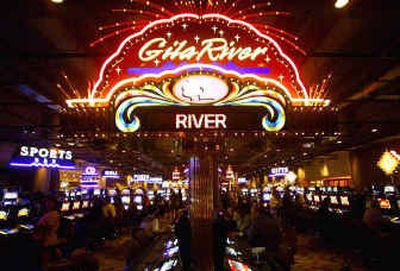The jackpot grows

WASHINGTON — Indian gambling pulled in $18.5 billion in 2004, nearly double the take for Nevada’s gambling industry, as tribal casinos boomed ahead.
The 10 percent increase extended more than a decade of double-digit growth for the nation’s Indian casinos, which have mushroomed since Congress passed a law creating the legal framework in 1988.
There now are 411 Indian casinos in the United States, operated by 223 tribes in 28 states. More than half the 341 federally recognized Indian tribes in the continental United States operate casinos.
Because tribes are sovereign nations, they don’t have to pay state or local taxes and are exempt from most zoning and other laws, a special status that can cause conflict with neighbors. Tribal casinos have met opposition from some local communities that don’t want the traffic or strain on resources.
To head off opposition, tribal leaders have grown more aggressive about asserting benefits. National Indian Gaming Association officials said Tuesday that tribal gambling has directly or indirectly created 553,000 jobs, mostly for non-Indians, and that it generated $5.5 billion in federal taxes in 2004.
Tribal leaders say gambling has allowed them to lift their reservations out of poverty.
“We had to overcome insurmountable odds to turn our economy around. We looked to casino gaming as a way to do that,” said Dee Pigsley, chairwoman of the Confederated Tribes of Siletz, which has a casino in Oregon. “No other development could return the kind of profits that a casino could offer.”
Major Nevada resorts took in $9.88 billion in gambling revenue in the 2004 fiscal year. Overall, revenue at Nevada resorts, including from hotels and restaurants, was $19.59 billion in 2004. That figure for Indian casinos was $21 billion.
“We are creating economic activity that benefits our communities and surrounding communities,” said Mark Van Norman, executive director of the National Indian Gaming Association.
The growth of the industry has been “completely unexpected and spectacular,” said I. Nelson Rose, who teaches gambling law at Whittier Law School in Costa Mesa, Calif. He and other experts predicted it could continue at the same level for some time.
“At a certain point it may level off because we’ll have more of the tribes built out,” Van Norman said in an interview. “But we’re still seeing tribes that are looking to develop new projects so we’re going to see continued strong growth for some time.”
Tribal officials said the biggest growth areas are California and New York. California Gov. Arnold Schwarzenegger has sought to tap tribal casino revenue to close the state’s budget deficit, while Gov. George Pataki wants to bring five Indian casinos to the Catskills as part of a deal to settle tribal land claims.
Nevada officials have occasionally expressed concerns that tribal casinos could eat into their profits, but Nevada casinos are generating record profits, too.
“We think we have a different market,” Ernest L. Stevens, chairman of the National Indian Gaming Association, said in an interview. “If Indian gaming were to go away they all wouldn’t run to Vegas.”
The figures released Tuesday were an estimate for the 2004 calendar year based on data from tribes. No figure for net profits was provided. Final figures will be released in the summer by the National Indian Gaming Commission.